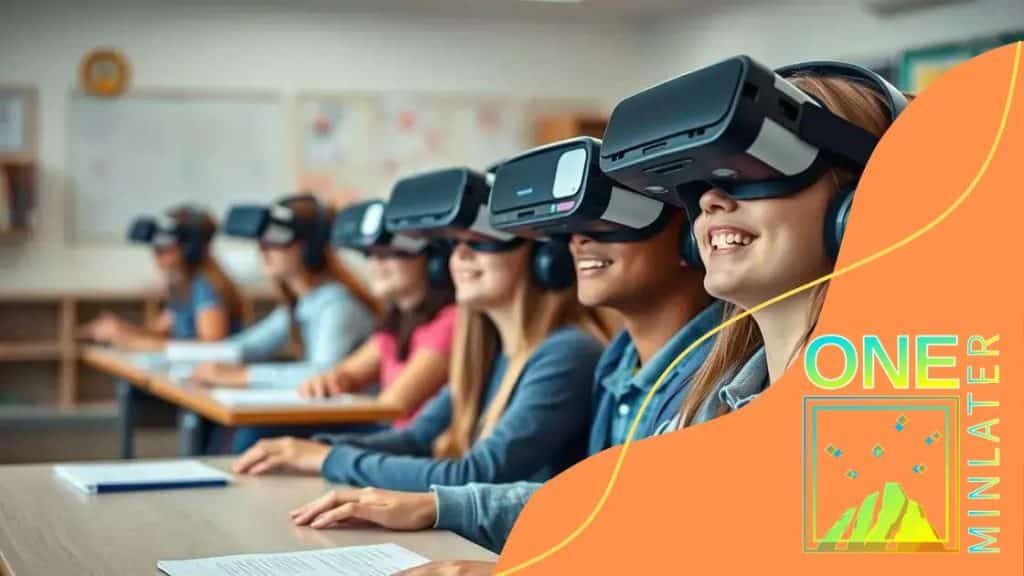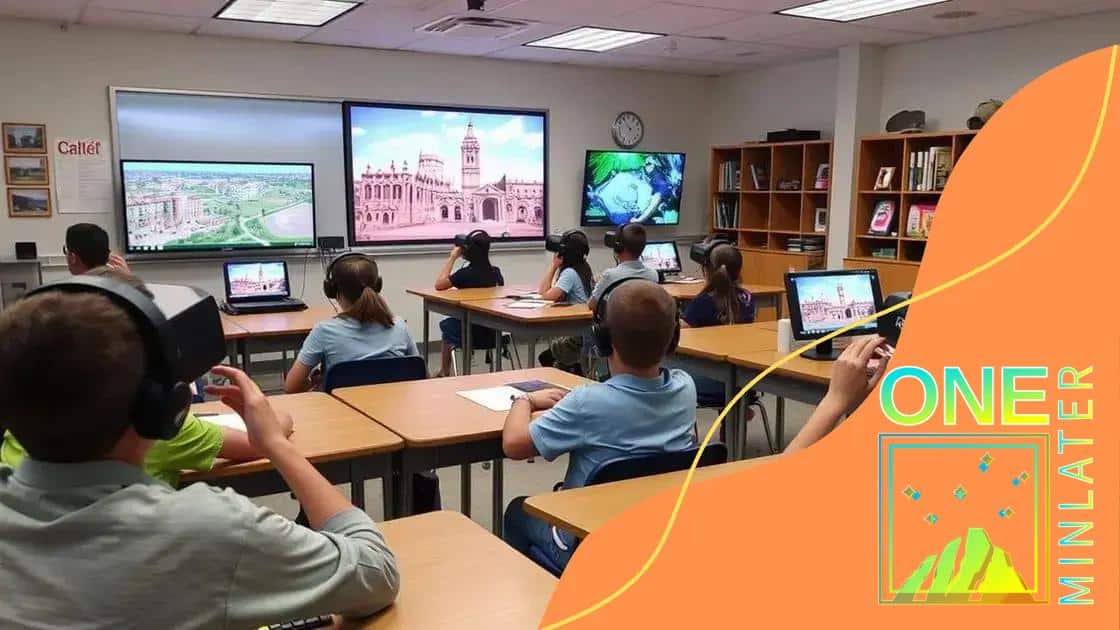How schools are integrating virtual reality in education

Schools are integrating virtual reality in education to enhance engagement, provide immersive learning experiences, and support diverse learning styles, despite challenges like cost and technical training.
How schools are integrating virtual reality in education offers exciting opportunities to enhance learning. Have you ever imagined walking through ancient cities or exploring the human body right from your classroom? Let’s dive into how this technology is reshaping education.
Understanding virtual reality in education
Understanding virtual reality in education is essential for grasping how this technology impacts students today. Virtual reality (VR) creates immersive environments that allow learners to explore and engage with content like never before.
In classrooms, VR makes learning interactive and exciting. Imagine being able to travel through time or explore space, all from your desk! This technology enhances engagement and retention, making lessons unforgettable.
What is virtual reality?
At its core, virtual reality is a computer-generated environment that simulates real or imagined experiences. Students wear headsets that transport them to these immersive worlds. Through VR, education gains a whole new dimension, sparking curiosity and exploration.
Benefits of virtual reality in education
- Enhanced engagement: Students are more likely to participate in lessons when they can experience them firsthand.
- Improved retention: The immersive nature of VR helps students remember concepts better.
- Inclusive learning: VR can cater to different learning styles, making education accessible for all.
- Safe environments: Students can practice skills or scenarios in a risk-free setting.
This technology isn’t just about playing games; it can teach empathy, teamwork, and problem-solving. For instance, VR experiences can put students in the shoes of someone from a different culture, fostering understanding and compassion. As students explore these virtual worlds, they develop critical thinking skills essential for success.
Limitations of virtual reality
While virtual reality presents many benefits, some challenges exist. Cost can be a barrier for many schools, limiting access to this technology. Additionally, educators must be trained to use VR effectively, ensuring that it fits into the curriculum meaningfully.
Despite these challenges, the potential of VR in the educational landscape is significant. As technology continues to evolve, so too will the ways it enhances learning experiences for students. The future of education might very well be envisioned through a virtual lens.
Benefits of using virtual reality in classrooms
The benefits of using virtual reality in classrooms are numerous and impactful. Virtual reality enhances the way students learn by providing immersive experiences that traditional teaching methods cannot match.
For example, imagine students exploring coral reefs or walking through historical landmarks without leaving their seats. This level of engagement captivates learners and helps them grasp complex concepts more easily.
Key advantages of virtual reality
Some key advantages include:
- Increased engagement: Students are often more motivated to learn when they can interact with the material in a vivid, hands-on way.
- Real-world applications: VR allows students to apply their knowledge in simulated environments, preparing them for real-life situations.
- Personalized learning: This technology can cater to various learning styles, catering to visual, auditory, and kinesthetic learners.
- Enhanced collaboration: VR can provide collaborative experiences where students can work together in virtual spaces, promoting teamwork and communication skills.
Moreover, VR breaks down geographical barriers. Students can explore the Amazon rainforest one moment and the surface of Mars the next. This ability to travel across time and space fosters curiosity and encourages self-directed learning.
Improving retention and understanding
The immersive nature of VR significantly aids in retention. When students interact with and visualize the material, they are more likely to remember what they learn. For instance, learning about the human body in VR allows students to see organs in 3D, providing a clearer understanding than a textbook ever could. Such innovative methods elevate the learning experience.
Additionally, using VR can cater to students with disabilities, offering tailored experiences that enhance their educational journey. Overall, incorporating virtual reality into the classroom holds potential for innovative teaching and learning methods that can benefit all students.
Different applications of virtual reality in schools

The different applications of virtual reality in schools are revolutionizing education. With this innovative technology, classrooms are transforming into interactive learning environments.
Students can dive into history by walking through ancient civilizations or explore the human body in 3D. These experiences make lessons memorable and engaging.
Common applications of virtual reality
Here are several common applications:
- Virtual field trips: Students can visit museums, forests, or even space without leaving the school.
- Simulated science experiments: VR allows students to conduct experiments in a safe, controlled setting, promoting hands-on learning.
- Language immersion: Students can practice new languages by interacting with virtual environments where the language is spoken.
- Historical reenactments: Learners can experience significant events, helping them understand context and implications firsthand.
Furthermore, VR aids in teaching complex subjects. For instance, in mathematics, students can visualize geometric shapes and spatial relationships, making abstract concepts more concrete. The ability to manipulate 3D models enhances comprehension.
Some schools are even using VR for social-emotional learning. By stepping into someone else’s shoes, students can develop empathy and understanding for others. Scenarios simulate real-life challenges, preparing students for social interactions.
Innovative storytelling and creativity
Additionally, VR stimulates creativity through interactive storytelling. Students can create their virtual worlds, sparking imagination and encouraging problem-solving. This hands-on approach can lead to increased enthusiasm for projects and themes.
In conclusion, the use of virtual reality in schools enhances learning experiences beyond traditional methods. The ability to engage with the content actively prepares students for a dynamic and rapidly changing world.
Challenges in integrating virtual reality
The challenges in integrating virtual reality into educational settings are significant. While this technology offers exciting opportunities, several barriers hinder its widespread adoption.
For one, the cost of VR equipment can be quite high. Schools may struggle to afford headsets, software, and the necessary infrastructure. This often leads to unequal access among students, with some experiencing the benefits of VR while others do not.
Technical challenges
In addition to costs, technical issues can arise. Many teachers are not familiar with VR technology and may require training to use it effectively. This lack of technical knowledge can lead to underutilization of VR resources. Without proper training, teachers might feel uncertain about how to incorporate VR into their lessons.
Content availability
Another challenge is the availability of suitable content. While VR experiences are growing, not all subjects have developed VR resources. Educators might struggle to find high-quality, relevant content that aligns with their curriculum.
Moreover, VR can be overwhelming for some students. Those who experience motion sickness or anxiety in immersive environments may find it difficult to engage with the technology. Schools must consider these individual differences when implementing VR in the classroom, ensuring that lessons are designed to be inclusive.
Finally, safety concerns also play a role. When using VR, students may need to move around, which can lead to accidents if the space is not properly prepared. Teachers must be vigilant in monitoring students to ensure a safe and effective learning experience.
Future trends in virtual reality for education
Future trends in virtual reality for education are set to transform classrooms even more. As technology advances, VR has the potential to make learning more engaging and accessible for everyone.
One major trend is the rise of affordable VR technology. Companies are working to lower the cost of headsets, making it easier for schools to integrate this technology. As prices drop, more classrooms can adopt VR and provide equal learning opportunities.
Enhanced learning experiences
Another important trend is the development of new, interactive learning experiences. Educators can create personalized lessons using VR, which caters to different learning styles. This customization can improve student engagement, helping each child learn in the way that suits them best.
- Integration with other technologies: Combining VR with augmented reality (AR) can create mixed-reality experiences, allowing students to interact with both the digital and physical worlds.
- Collaborative VR experiences: Students around the world can connect and learn together in virtual environments, fostering cross-cultural understanding and teamwork.
- AI and VR: Artificial intelligence can tailor learning experiences in VR, adapting the content based on student performance and preferences.
- Experiential learning: Virtual field trips and simulated real-world scenarios will continue to grow, enriching students’ understanding of complex topics.
Moreover, teacher training programs are likely to include VR to help educators develop the skills they need to use this technology effectively. This professional development can empower teachers to create engaging, innovative lessons that captivate their students.
The role of gamification
Additionally, gamification will play a larger role in virtual reality education. By incorporating game-like elements, such as rewards and challenges, VR can motivate students to immerse themselves in their learning. This fun approach can lead to higher retention and a deeper understanding of the material.
As we look to the future, the impact of virtual reality in education will only increase. With advances in technology, the possibilities for enhancing learning experiences are limitless, making education more exciting and effective for all students.
FAQ – Frequently Asked Questions about Virtual Reality in Education
What are the main benefits of using virtual reality in the classroom?
Virtual reality enhances engagement, allows for immersive learning experiences, and helps students understand complex topics more effectively.
What challenges do schools face when integrating virtual reality?
Challenges include high costs, lack of technical training for teachers, and ensuring that all students have access to the technology.
How can virtual reality support different learning styles?
VR provides interactive experiences that cater to visual, auditory, and kinesthetic learners, making lessons more accessible and engaging.
What is the future potential of virtual reality in education?
The future includes advancements in affordable technology, enhanced collaborative learning, and integration with artificial intelligence for personalized experiences.





